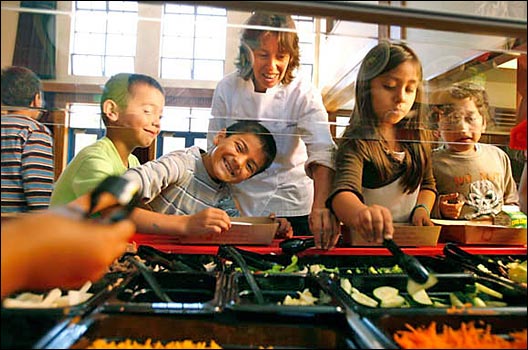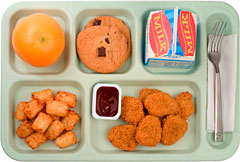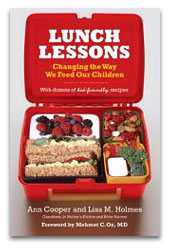Even the most intractable pathology can disappear, sometimes relatively quickly. A sign above a water fountain proclaiming “no coloreds” would cause any American to flinch today. Just half a century ago throughout the South, such abominations formed a banal part of the built landscape.
 Ann Cooper puts a fresh spin on school lunches.Photo: Chronicle/Craig LeeI got to thinking about deep-rooted problems and rapid change a few days ago while talking with Ann Cooper, a former star chef who now proudly styles herself a “renegade lunch lady.” Cooper is on a mission to transform the nation’s abysmal school-lunch system. I met her for a cup of coffee in Asheville, N.C., where she was promoting her new book Lunch Lessons: Changing the Way We Feed Our Children. After our conversation, I began to wonder if the idea of pumping kids full of flavorless, nutritionally suspect convenience food at school might soon become as socially unacceptable as Jim Crow-style racism.
Ann Cooper puts a fresh spin on school lunches.Photo: Chronicle/Craig LeeI got to thinking about deep-rooted problems and rapid change a few days ago while talking with Ann Cooper, a former star chef who now proudly styles herself a “renegade lunch lady.” Cooper is on a mission to transform the nation’s abysmal school-lunch system. I met her for a cup of coffee in Asheville, N.C., where she was promoting her new book Lunch Lessons: Changing the Way We Feed Our Children. After our conversation, I began to wonder if the idea of pumping kids full of flavorless, nutritionally suspect convenience food at school might soon become as socially unacceptable as Jim Crow-style racism.
Cooper has certainly taken on a daunting task. She currently serves as nutrition director of the Berkeley Unified School System, a 16-school, 9,000-student outfit in California. When she took the job in 2005, she found that the district’s food-service system had completely retreated from actual cooking. “When I arrived, 100 percent of the food arrived in plastic, was reheated in plastic, and served to the kids in plastic,” she says.
Overcoming an absurdly stringent budget and severely limited cooking infrastructure within school cafeterias, she has already eliminated what she calls “plastic food” and is now serving fresh, made-from-scratch meals. But she has no intention of stopping there. She would like to overthrow the logic that has made school cafeterias conduits through which convenience-food manufacturers reach children’s impressionable palates.
That job won’t be easy. Few school districts can afford to hire a skilled chef with a sterling resume (Culinary Institute of America, a celebrated run as executive chef at Vermont’s Putney Inn) to oversee a cooking revolution. In fact, the Berkeley system can only afford to fund Cooper’s salary through a three-year grant from the Chez Panisse Foundation.
For less-lucky school districts, the situation is grave. As Cooper puts it in Lunch Lessons, “a full 78 percent of the schools in America do not actually meet the USDA’s nutritional guidelines.” It’s no wonder, really: Cooper says school cafeterias have $2.40 per day to spend on each kid — 70 percent of which goes to payroll and overhead. That leaves 72 cents to spend on ingredients.
Given those Dickensian financial constraints, it’s also no wonder that over the last 30 years, schools have replaced trained cooks with de-skilled workers and abandoned cooking for reheating.
All in all, Cooper told me, the U.S. spends about $7 billion per year on school lunches — roughly equal to a month’s worth of military expenditures in Iraq [PDF].
The comparison is not merely rhetorical. As budget deficits mount and the president keeps escalating — pardon me, augmenting — the nation’s commitments to the deadly sinkhole that has become Iraq, it’s going to become harder and harder to find money to improve the dismal state of school lunches.
Penny Wise, Dollar Poor
Although money that could be boosting school-lunch budgets is now vainly being dumped into Iraq, defense planners once saw great value in childhood nutrition. In fact, Cooper reports, the school-lunch program grew out of national-security concerns.
According to Cooper, it started during World War II, when military planners discovered that widespread malnutrition among the nation’s youth was hampering their ability to fight effectively. In the initial post-war decades, the school-lunch program worked pretty well, Cooper says. “There were actually real people cooking food from scratch in every public school in the country,” she adds. “And no one thought about charging — meals were free for every kid.”
But economic crisis in the mid-1970s galvanized the backlash against New Deal programs that continues to grip U.S. politics to this day. As kitchen equipment installed in the 1940s and 1950s began to decay, Congress didn’t allot money to replace it. Skilled cooks — the “lunch ladies” Cooper harks back to — reached retirement age, and their jobs went unfilled. School kitchens gradually turned into reheating centers staffed by button-pushers, not cooks, and school districts began to outsource food preparation to a booming convenience-food industry, which was just then discovering the wonders of high-fructose corn syrup and hydrogenated fat.
Fast-forward 30 years, and we’ve completed a vicious circle. If the school-lunch program started from an urgent need to counter rampant malnutrition, it now needs a complete overhaul to combat a new scourge: surging diabetes and obesity rates.

These are the trays.
Photo: iStockphoto
Cooper points to a recent finding by the Centers for Disease Control and Prevention that among children born in 2000, one in three white kids and fully half of African Americans and Hispanics will develop diabetes in their lifetimes — most before finishing high school. If present trends hold, these Americans will be the first in the nation’s history not to live longer than their parents.
“Already, diet-related illnesses [in the U.S.] are costing $70 billion per year in health-care expenses” among adults and children, Cooper says. “When the current generation of kids enters adulthood, that number will explode.”
All over the nation, grassroots efforts to reform school lunches are springing up, yet they remain severely constrained by the budget situation. That’s why Cooper is turning her gaze to national politics.
Today Berkeley, Tomorrow the World
For 30 years, cutting costs has been the dominant goal of school food-service programs. But the pennies pinched in school cafeterias will likely seem paltry compared to the cost of treating tens of millions of chronically ill adults.
Thus Cooper would like to bring health and sustainability to the fore. She wants to see school lunches universally cooked from scratch with fresh and, when possible, local ingredients. And she believes strongly that the public sector, not parents, should pay.
“Kids don’t just learn math and history and science at school,” she says. “They also learn how to eat, how to take care of themselves. No parent expects to get a bill for math class. Why should they get a bill for lunch? Food needs to be seen as part of the curriculum.”
Making that happen will require reinvestment in kitchen infrastructure and much higher annual budgets for the school-lunch program. To overcome the crushing inertia of U.S. politics and revive the school-lunch program, Cooper says, “We’ll need to make children’s health a key issue in the 2008 election.”
How to make that happen in a political culture constrained by tax cuts and mounting war bills? “I’ve got to get myself on Oprah.”
She’s not joking. In the United Kingdom, where school lunches until recently were even worse than those in the U.S., chef Jamie Oliver put his considerable celebrity behind a successful push toward healthy, fresh food in schools. Oliver’s highly publicized cajoling forced the government to boost the school-lunch budget by about 30 percent. No U.S. chef who emphasizes sustainability and health issues has anything close to Oliver’s popular stature.
But Cooper, illuminated by Oprah’s powerful media glow, could do something similar. If a Democrat gains the presidency in 2008, Cooper told me, she hopes to take a position in the administration as a kind of uber-Lunch Lady, from which vantage real reform could begin.
Can this chef-activist really change things nationwide? She has faced down challenges before. As a kid, she struggled academically, and eventually dropped out of high school in the early 1970s to pursue skiing opportunities in Telluride, Colo. (“Today, I’d almost certainly be diagnosed with dyslexia or ADD,” she says.) Quickly finding herself penniless as a ski bum, she “did what any Jewish American Princess would do: I called my parents and begged for money.” They declined, and Cooper sought work in the male-dominated restaurant world. Immediately, she fell in love with food.
Cooper shrugged off the chef profession’s stifling machismo and established herself as an innovator in New American cuisine by the 1990s — the trend that made local, seasonal, and organic key words in the high-end food world. She also shrugged off her lack of formal education and has authored four well-received books on food politics and culture.
Normally I don’t place much faith in electoral politics, but Cooper’s sheer force of personality made me believe she could use the system to make the change so desperately needed by an increasingly sick and overweight nation.
After more than an hour of intense conversation with the Lunch Lady, I needed some lunch myself. I chose a small restaurant in Asheville that specializes in local, seasonal food. I sat at the bar overlooking the kitchen, where a young woman chef, working at breakneck speed, ran the line all by herself. Clearly, someone hadn’t shown up.
I reflected that not so long ago, Asheville had no restaurants focusing on local ingredients, and now it has several. Nor were there many female chefs, and here was one doing virtuosic work, and it didn’t seem unusual.
Cooper blazed a trail for women in the restaurant world, and helped spark the local-food ethos that now grips high-end U.S. cooking. If I were a Kraft exec counting on school cafeterias for long-term profit, I’d be worried.



